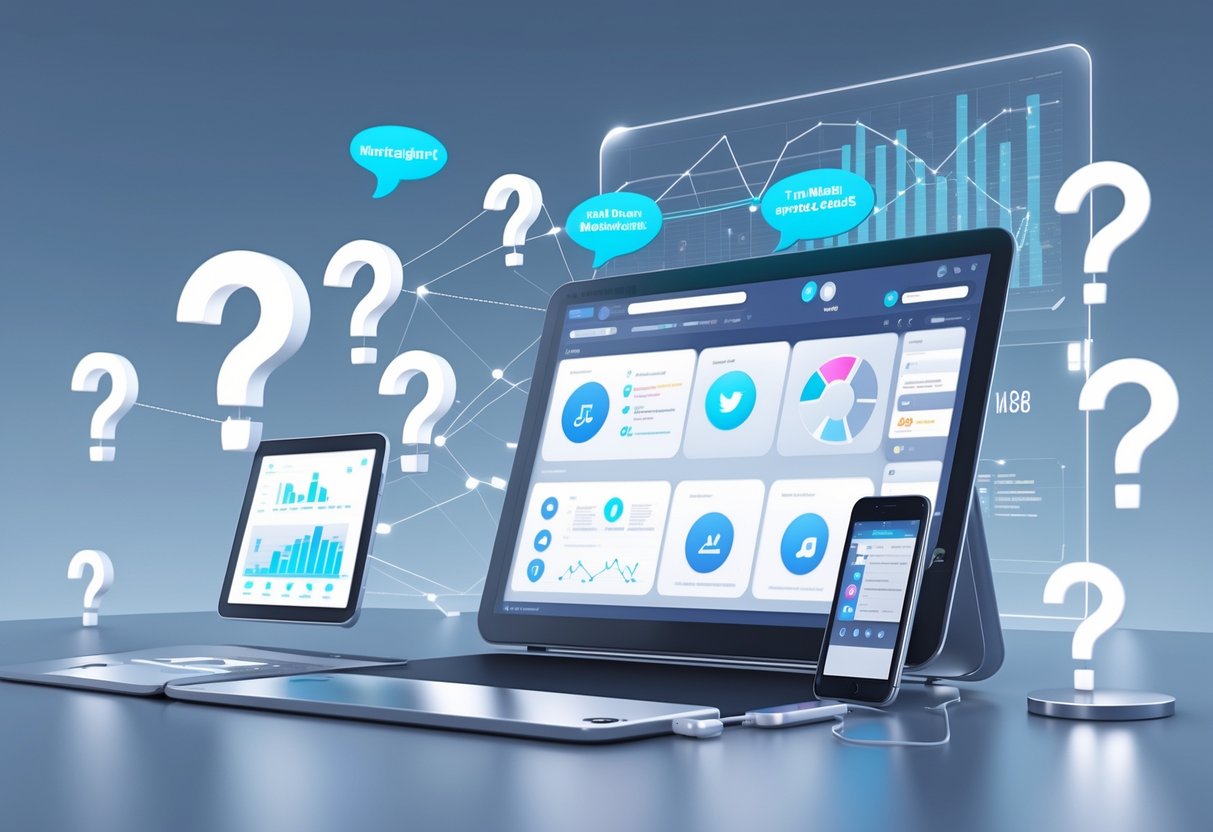Social Media Management: Strategies, Tools and Best Practices
Updated On: October 26, 2025 by Aaron Connolly
Understanding Social Media Management
Social media management means creating, scheduling, and analyzing content across different platforms to boost brand awareness and connect with your audience. It’s a blend of strategy and daily interaction, and honestly, it takes both creative flair and a knack for numbers to get it right.
Definition and Core Principles
When we talk about social media management, we mean handling a brand’s presence on platforms like Instagram, Facebook, Twitter, and LinkedIn. Our goal is to craft content that actually connects with people, not just fills a feed, while building genuine relationships.
Consistency, authenticity, and engagement really drive this whole thing. If you post regularly, folks remember you. If you’re real, they trust you.
Key activities:
- Creating and scheduling posts
- Responding to comments and messages
- Analyzing performance metrics
- Planning content campaigns
- Monitoring brand mentions
We judge our success by engagement rates, follower growth, and website traffic. These numbers tell us if our content is actually hitting home.
Some essential tools make life easier:
- Scheduling platforms like Hootsuite or Buffer
- Analytics dashboards for tracking performance
- Design software for visuals
- Social listening tools to keep an ear on conversations
You’ve got to understand each platform’s vibe and what people expect there. TikTok’s crowd isn’t looking for the same stuff as LinkedIn’s, and that’s just how it is.
Social Media Management vs Social Media Marketing
Social media management and marketing aren’t quite the same, even though they often overlap. Management is all about daily operations and building a community. Marketing leans more into promotional campaigns and driving sales.
Social media management covers:
- Daily content creation and posting
- Community engagement and customer service
- Brand reputation monitoring
- Building real relationships with followers
Social media marketing focuses on:
- Paid advertising campaigns
- Lead generation strategies
- Sales funnel development
- Promotions aimed at ROI
We use management to keep our brand present and consistent. Marketing is what we use when we want people to buy, sign up, or take action.
Both sides matter. Good management sets the stage for marketing to actually work. If your community’s engaged, they’re way more likely to respond to your promos.
Most businesses end up needing both. Smaller companies might do management themselves and hire out for marketing. Bigger companies usually split the roles.
Roles of a Social Media Manager
A social media manager juggles a lot. We create posts, chat with followers, dig into analytics, and map out strategies that fit the company’s bigger goals.
Day-to-day, we:
- Write and design posts
- Respond to comments and messages
- Watch for brand mentions
- Update content calendars
On the strategy side:
- Build content strategies
- Analyze data
- Plan campaign launches
- Work with marketing teams
We also jump in fast if negative feedback pops up online. Quick, thoughtful replies can save a brand’s reputation.
Skills that really matter:
- Creative writing and design
- Data analysis
- Customer service instincts
- Knowing how platform algorithms work
Staying on top of the latest social media trends and updates is non-negotiable. Algorithms change, and suddenly your reach tanks or takes off.
It’s a balancing act—being creative, but also paying attention to what actually moves the needle for the business.
Developing an Effective Social Media Strategy

A solid social media strategy starts with clear goals, a deep understanding of your audience, and a close eye on competitors. These three things work together to help you create campaigns that actually get results.
Setting Objectives and KPIs
Before you post anything, you’ve got to figure out what you want to achieve. Clear objectives make every decision easier.
SMART goals work best:
- Specific: “Increase Instagram followers” isn’t enough—try “Get 500 new Instagram followers”
- Measurable: Track real numbers, not just “improve engagement”
- Achievable: Don’t expect 100,000 followers in a month
- Relevant: Tie goals to your business priorities
- Time-bound: Give yourself a deadline—monthly or quarterly works
Some useful metrics:
| Objective | Primary KPI | Secondary KPI |
|---|---|---|
| Brand awareness | Reach and impressions | Share of voice |
| Engagement | Likes, comments, shares | Average engagement rate |
| Lead generation | Click-through rate | Cost per lead |
| Sales | Conversion rate | Revenue attribution |
Don’t get lost in too many numbers. We usually stick to 3-5 KPIs. Any more and it gets messy.
Check your numbers every week, but really review your strategy monthly. Social media changes fast, so you want to catch issues before they snowball.
Identifying Target Audience
Knowing who you’re talking to shapes everything—what you post, where you post, and how you say it. Generic content just doesn’t cut it.
Start with the basics:
- Age and generation
- Location and time zone
- Income and job type
- Interests and hobbies
Turns out, 41% of consumers use social media to research brands. For Gen Z and millennials, that number’s even higher.
Go deeper:
- Which platforms do they love?
- When are they online?
- Do they prefer video or text?
- What problems are they trying to solve?
Build 2-4 buyer personas. Any more, and it gets overwhelming.
Use social listening tools:
- Watch for brand mentions and hashtags
- See who’s engaging with your competitors
- Find trending topics in your industry
- Notice what’s missing in the conversation
Focus on engagement, not just follower count. A small but active community beats a big, silent one any day.
Competitor and Trend Analysis
If you don’t know what your competitors are doing, you’re probably missing out. Smart analysis helps you spot gaps and opportunities.
Here’s what to look for:
- Which platforms are they on?
- What content gets the most love?
- How often do they post?
- What hashtags show up again and again?
- How do they handle customer service?
Don’t just copy them. Take what works, skip what doesn’t, and make it your own.
Stay on top of trends:
| Trend Type | Examples | Impact on Strategy |
|---|---|---|
| Content formats | Short-form video, live streaming | Adjust content calendar |
| Platform features | Instagram Shopping, LinkedIn newsletters | Try new features early |
| User behaviour | Social commerce growth | Add shopping tools |
Keep an eye on industry trends:
- Follow hashtags and keywords
- Join professional groups
- Subscribe to industry news
- Show up at virtual events
Set aside a little time each week for trend analysis. Social media never sits still, and what worked last month might flop today.
Trends come and go, but if you really understand your audience and competitors, you’ll always have an edge.
Choosing the Right Social Media Platforms
Your platform choices can make or break your social media efforts. You need to know where your audience hangs out and tweak your content for each platform’s unique style.
Evaluating Platform Demographics
We have to match our audience with platform demographics before diving in. Facebook is still the world’s biggest platform, mostly with users aged 25-54.
Instagram is younger, with 67% of users under 35. It’s perfect for visual content and storytelling.
TikTok rules the 16-24 crowd. Short videos get crazy engagement, and the algorithm loves creativity more than follower count.
LinkedIn is all about professionals and B2B. With 80% of users aged 25-55, it’s great for networking and thought leadership.
Think about your customers. A news brand might do better on Twitter/X, while fashion and food shine on Instagram and Pinterest.
YouTube reaches all ages but takes more effort to produce good video. Start where your audience already spends time.
Platform-Specific Approaches
Each platform has its own rules, so you’ve got to tailor your strategy. TikTok is all about authentic, fast-moving content with trending sounds.
Instagram wants polished visuals, a consistent look, and smart use of Stories and Reels. Timing your posts actually matters here.
Facebook works best for community building and longer posts. Groups and events get more traction than regular updates.
LinkedIn likes professional insights, industry news, and thought leadership. Oddly enough, personal profiles often get more attention than company pages.
Formats are all over the place. TikTok’s vertical videos won’t work on LinkedIn’s feed.
We need to adjust our brand voice for each platform but still stay consistent overall. Be professional on LinkedIn, casual on TikTok, and visual on Instagram.
Try different posting times and content types. Most platforms give you analytics, so use them to see what clicks with your crowd.
Content Planning and Creation
If you want your social media to work, you need the right content at the right time. Planning ahead keeps you organized, helps you post consistently, and makes it way easier to hit your marketing goals.
Building a Social Media Content Calendar
A content calendar is your secret weapon for staying on track. It keeps all your themes, schedules, and campaigns in one spot.
Start by picking 4-6 big topics that match your business goals and what your audience actually cares about.
Then, decide how often you’ll post on each platform. Most brands post 3-5 times a week on Facebook and Instagram. Twitter can handle more.
Key things to include:
- Dates and times for posts
- Which platform each post is for
- Content type (video, image, text)
- Captions and hashtags
- Approval status
You can use a simple spreadsheet or a fancy scheduling tool. Lots of teams batch content creation once a month, then schedule posts a week or two ahead.
Don’t forget seasonal events, launches, or dates that matter to your industry. Planning ahead saves you from last-minute chaos and missed chances.
Types of Social Media Content
There are a few main types of social media content, and each one serves a different purpose. Mixing them up keeps things interesting and helps you reach your goals.
Educational content shows you know your stuff. Share tips, how-tos, and insights that actually help your audience. People love it, and it builds trust.
Behind-the-scenes content gives your brand a human touch. Show your team, your workspace, or how you create your products.
User-generated content is gold. When your community shares photos or stories about your brand, it’s social proof and saves you time.
Promotional content is where you show off your products or services. Don’t overdo it—keep this to about 20-30% of your posts.
Entertainment content—think memes, trending topics, or just fun posts—can really boost engagement if it fits your brand.
Aim for the 80/20 rule: 80% valuable or entertaining, 20% promo.
Content Creation Best Practices
Good content creation takes planning, consistency, and a little attention to detail. Focus more on quality than cranking out tons of posts.
Batch your content to save time and keep your brand’s look consistent. Set aside days for taking photos, writing, or filming videos instead of scrambling every day.
Keep your visuals consistent. Pick a color palette, fonts, and filters that show up in every post. Templates help, especially for recurring stuff like quotes.
Optimize for each platform:
- Instagram: Square images (1080x1080px)
- Facebook: Landscape (1200x630px)
- Twitter: 16:9 ratio (1200x675px)
Write captions that spark conversation—ask questions, run polls, add a call to action. Use hashtags, but don’t go overboard: 5-10 for Instagram, 1-2 for Facebook and Twitter.
Plan around trends and seasonal events, but don’t lose your brand’s voice. Jumping on trends can get you noticed, but only if it fits your audience.
Try out different formats: carousels, stories, reels, even live videos. Watch what works by checking your metrics, then tweak your strategy to match what your followers actually like.
Publishing and Scheduling Content
Publishing content at the right moment really can make a difference for your social media game. The best posting times change depending on your platform and audience, and automation tools help you stay consistent without needing to hover over your phone all day.
Optimal Posting Times
Timing matters more than people think. Maybe your audience scrolls through Instagram at 7am, but prefers LinkedIn during lunch.
Platform-Specific Peak Hours:
Every platform has its own sweet spot for engagement. Instagram gets the most action early in the morning (6-9am) and again in the evening (7-9pm).
LinkedIn users show up most during weekday lunch breaks (11am-1pm) and in the early evenings. Facebook peaks mid-week between 9-10am and again at 3-4pm.
Twitter? People flock there during commute times and lunch breaks on weekdays.
Understanding Your Audience:
Generic timing tips only go so far. Your followers might have their own routines depending on where they live, how old they are, and what they’re into.
Dig into your analytics to see when your crowd actually logs on. Instagram Insights breaks it down by day and hour.
Try out different times for a few weeks. Track which posts get the most love and see if you can spot a pattern.
Automation and Scheduling Tools
Scheduling tools have changed how we handle social media. Instead of posting in real time, you can create a bunch of content at once and let the tools do the heavy lifting.
Popular Scheduling Platforms:
Hootsuite covers all the big names—Instagram, Facebook, Twitter, LinkedIn, TikTok. It’s a bit pricey, starting at £99 a month, but you get advanced analytics and team features.
Later is great for visual planning, especially if you care about how your Instagram grid looks. The basic plan starts at £25 monthly.
Buffer keeps things simple. It’s perfect for small teams. Their free plan lets you schedule for one channel, while paid options start at £5 a month.
Advanced Automation Features:
Modern tools offer more than just scheduling. You can bulk upload content and set up weeks’ worth of posts in one go.
Auto-posting from RSS feeds keeps your accounts fresh with blog updates. Some tools even suggest the best posting times based on your past performance.
Team collaboration features let several people draft, review, and approve posts before they go live. This helps avoid mistakes and keeps your branding on point.
Community Engagement and Social Listening

Building strong communities means you need to listen to your audience and respond in ways that actually matter. If you keep an eye on conversations, you’ll spot chances to jump in and make real connections.
Responding to Audiences
Quick replies show people you care about what they have to say. Try to get back to folks within 2-4 hours during business hours—quicker is even better.
Your response strategy should include:
- Thanking people for positive feedback and shares
- Addressing complaints directly and publicly when you can
- Asking follow-up questions to keep chats going
- Matching the tone your audience prefers
Different platforms need different vibes. Twitter works best with short, casual replies. LinkedIn needs a more professional touch. Instagram? Go for emojis and a friendly voice.
Heads up: Don’t delete negative comments unless they cross the line. Respond professionally, and if things get heated, move the chat to private messages.
Set up templates for common replies. That way, you save time but still sound like yourself everywhere.
Encouraging Community Participation
Communities thrive on regular interaction and shared experiences. Focus on content that naturally gets people talking.
Effective participation tactics include:
- Asking direct questions in your posts
- Running polls and surveys
- Sharing behind-the-scenes moments
- Creating branded hashtags
- Hosting live Q&As
Quick win: Try “This or That” questions with images. People love those and they’re easy to make.
User-generated content brings everyone closer. Invite your followers to share their photos, stories, or reviews using your hashtag. Always give them a shoutout when you share their stuff.
Consider setting up exclusive groups on Facebook or Discord. These spaces encourage deeper conversations and help your community bond.
Monthly challenges or weekly prompts keep people coming back. Give your audience a reason to participate regularly.
Monitoring Mentions and Conversations
Social listening isn’t just about tracking when people tag you. Keep an eye on industry topics, competitors, and related keywords to find new ways to join relevant conversations.
Essential monitoring includes:
- Brand name mentions (tagged and untagged)
- Industry hashtags and keywords
- Competitor mentions
- Customer service questions across platforms
| Monitoring Type | Tools Needed | Response Time |
|---|---|---|
| Direct mentions | Native platform notifications | Within 1 hour |
| Industry keywords | Social listening tools | Within 4 hours |
| Competitor mentions | Advanced monitoring software | Daily review |
Social media listening helps you spot trends before everyone else. Jump into hot topics early and position yourself as a thought leader.
Set up Google Alerts for your brand and key execs. That way, you’ll catch mentions in blogs and on websites that your social tools might miss.
Keep an eye on sentiment, not just the number of mentions. A sudden spike in negativity needs your attention, even if your overall mentions look normal.
Analytics and Performance Measurement

To know if your esports social media is working, you need to track the right numbers and actually understand what they mean. Focus on engagement rates, reach, and conversion metrics that make a real difference for your growth.
Key Social Media Metrics
Engagement rate is king. You figure it out by dividing total likes, comments, and shares by your follower count, then multiplying by 100.
For esports, shoot for 3-5% engagement. Gaming fans are active, so if your number is lower, your content may need a rethink.
Reach and impressions show how many people see your stuff. Reach is unique viewers, impressions count every view—even repeats.
Check these each week:
- Follower growth rate (new followers divided by total followers)
- Click-through rate on tournament posts or highlights
- Video completion rates for gameplay clips
- Share rate for your top content
Each platform has its own thing. Twitch cares about average viewers and chat activity. YouTube looks at watch time and subscriber growth. Twitter? Retweets and replies matter most.
Google Analytics helps you track who’s coming to your site from social. Use UTM codes to see which posts bring in the most traffic.
Interpreting Analytics Data
Look for patterns in your top posts. Big tournaments usually pull in 40-60% more engagement than regular gaming updates.
Time-based analysis tells you when your fans are most active. Esports folks usually show up evenings (7-11 PM GMT) and weekends during tournaments.
Compare your numbers to industry averages. Gaming accounts hit about 2.4% engagement on Instagram and 1.8% on Twitter, according to the latest data.
Video posts tend to outperform static images by a huge margin—sometimes 300% more engagement in gaming circles.
If you’re pushing events or merch, track how many people actually sign up or buy after seeing your posts.
Keep an eye on your competitors. See how often they post, what kind of stuff they share, and how much people interact.
Don’t get hung up on vanity metrics like total followers. A smaller, active group of real esports fans is way more valuable than a big but silent crowd.
Check your analytics every week and tweak your approach based on what’s working. Pick the metrics that match your goals—whether that’s growing your fanbase or hyping up your next match.
Paid Social and Campaign Management

Paid social advertising lets you target specific groups with sponsored posts, video ads, and display content across Facebook, Instagram, TikTok, and more. Let’s dig into how to set up campaigns that actually reach the right people, then talk about managing your ad spend and getting better results.
Designing Social Media Campaigns
Start every campaign by figuring out who you want to reach and which platforms they actually use.
Define Your Campaign Goals
- Brand awareness? Focus on reach and impressions.
- Lead generation? Go for form fills and email sign-ups.
- Conversions? Push for sales or app downloads.
Different goals need different tactics. A B2B software brand might use LinkedIn to reach decision-makers, while an indie game studio could show off gameplay with TikTok ads.
Choose Your Targeting Strategy
Most platforms offer three main ways to target:
| Targeting Type | Best For | Example |
|---|---|---|
| Demographics | Broad reach | Age 18-34, gaming interests |
| Lookalike audiences | Finding similar customers | Users like existing players |
| Retargeting | Converting warm leads | Website visitors who didn’t purchase |
Start broad, then narrow down as you learn what works. Lookalike audiences based on your best fans often get strong results.
Managing Social Media Ads
Once your campaign goes live, you need a plan to watch performance and adjust your budget to get the most bang for your buck.
Set Up Tracking and Analytics
Install platform pixels on your website before you launch anything. Facebook Pixel, LinkedIn Insight Tag, TikTok Pixel—they all track what people do after clicking your ads.
Keep an eye on these numbers:
- Cost per click (CPC) – how much you pay for each click
- Conversion rate – percent of clicks that finish your goal
- Return on ad spend (ROAS) – revenue per pound spent
Optimise Budget Allocation
Start with small daily budgets (£10-20) to test different ad types and audiences. Once you spot what’s working, slowly raise your spend on the winners.
Most platforms use automated bidding, but you can still set max costs if you need to. If CPC goes over £2 for gaming, maybe tweak your targeting or try new creative.
A/B Testing for Better Results
Test one thing at a time—headline, image, button. Run your tests for 3-7 days to get enough data. Winning versions can bump your click-through rates by 15-30%.
Review your campaigns every week. Catch dips in performance early and tweak things based on the bigger picture, not just daily swings.
Leveraging Influencer Marketing

Influencer marketing connects esports brands with gaming personalities who already have loyal fans. If you find the right influencers and work with them the right way, you can reach more people and build trust in the gaming world.
Partnering with Influencers
Find influencers whose audience lines up with your target gamers. Look for streamers and creators who actually play the games your brand cares about.
Micro-influencers often deliver better results than mega-stars. Gaming creators with 10,000-50,000 followers usually have more engaged fans. Their communities trust them more than they trust big celebrities.
Check a few things before reaching out:
- Engagement rate (likes, comments, shares per post)
- Audience demographics (age, location, gaming interests)
- Content quality (posting regularly, good production)
- Brand fit (values that match yours)
See who else they’ve worked with lately. Avoid creators who promote too many competing brands—gamers spot when someone’s just cashing in.
Start small. Offer free products or short-term deals before you jump into anything long-term.
Best Practices for Influencer Collaboration
Let’s make clear agreements that work for everyone. Set out exactly what content you expect, when it goes live, and how you’ll measure success.
Let influencers do their thing. Gamers can spot fake, scripted content from a mile away. Give creators the space to show off your brand in their own voice.
Keep an eye on these key metrics:
- Reach (views, impressions)
- Engagement (comments, shares, clicks)
- Conversions (sign-ups, purchases, downloads)
Heads up: Always ask for proper disclosure. UK ad rules say you need clear tags like #ad or #sponsored on paid posts.
Aim for long-term partnerships instead of one-off shoutouts. When gaming influencers actually use your products, their followers can tell—and it just feels more real.
Pay on time and pay fairly. Trust matters in the gaming creator world, and people talk if brands mess around with payments.
Trends and Innovations in Social Media Management

AI tools are shaking up how we create content and run campaigns. New video styles—think vertical, interactive formats—are changing how brands connect with people.
The Role of AI in Social Media
AI isn’t just a buzzword anymore. Most marketers (about 69%) now see AI as a game-changer that actually creates jobs instead of taking them away.
Content Creation at Scale AI helps us keep up with the crazy demand for content. Studies suggest brands should post 48-72 times a week across all platforms. AI handles things like:
- Writing captions and social posts
- Making images and graphics
- Translating posts for global fans
- Drafting influencer proposals
Strategic Planning Support Social media strategists—especially execs and VPs—lean on AI more than content creators do. Over 75% of senior leaders in social strategy now use AI tools.
AI helps with campaign planning, analyzing audiences, and forecasting results. It even pulls together executive summaries and key insights for decision-makers.
Enhanced ROI Tracking AI-powered social listening gives us real-time insights that tie directly to revenue. Teams using these tools say they’re much more confident about proving ROI.
Emerging Content Formats
Video still rules social media, but the style keeps changing. Short, vertical videos (like reels) are now the norm pretty much everywhere.
Interactive and Entertaining Content Brands are leaning into entertainment, not just hard sells. Around 60% of social posts aim to entertain, teach, or inform.
Interactive formats are hot right now:
- Polls and question stickers
- Behind-the-scenes peeks
- User-generated content drives
- Live streams
Platform-Specific Adaptations Every platform needs its own approach. Reels work on Instagram, Facebook, and even LinkedIn these days. TikTok-style videos are popping up everywhere.
Cultural Trend Integration Smart brands focus on “micro-virality”—small, targeted content that clicks with their audience. Social listening helps spot trends that actually fit your brand.
This targeted approach usually works better than chasing every trending meme or hashtag.
Evaluating and Selecting Social Media Management Tools

Picking the right social media tool means weighing features, price, and how easy it is to use for your team. The best platforms balance scheduling, analytics, and collaboration—without breaking the bank.
Popular Tool Comparisons
Hootsuite stays a top pick for big teams juggling lots of campaigns. You get 150+ app integrations and a powerful dashboard.
They start at £79/month for the Professional plan. If you’re new, the learning curve can be a bit much.
Sprout Social stands out for analytics and CRM integration. Its smart inbox and social listening tools help you track customer chats.
Plans start at £199/month for Standard, so it’s best for agencies and data-driven marketers.
Agorapulse really focuses on engagement and community. Its inbox pulls in messages from everywhere.
You get detailed engagement reports and real-time listening built in.
| Tool | Best For | Starting Price | Key Strength |
|---|---|---|---|
| Hootsuite | Large teams | £79/month | App integrations |
| Sprout Social | Analytics focus | £199/month | CRM features |
| Agorapulse | Engagement | £89/month | Community management |
Choosing the Right Solution for Your Needs
Figure out what you need most. Small teams usually go for easy, affordable tools over fancy features.
Think about which platforms matter to you. If your brand is all about visuals, you’ll want strong Instagram and Pinterest support.
Budget matters—a lot. Free tools like Buffer’s basic plan work for solo creators. As you grow, you’ll probably need paid features for team stuff.
Team size plays a big role. Solo creators can stick with simple tools. Agencies need approval workflows and client management built in.
Analytics depth isn’t the same everywhere. Small businesses can get by with basic metrics. Bigger companies need deep-dive performance and competitor tracking.
Try free trials before buying. Most tools give you 14 days to see how they fit your workflow.
Integrating Social Media with Broader Digital Marketing

Good social media management means linking your channels with email, content marketing, and everything else digital. This keeps your message steady and gets the most out of your budget by making every channel work together.
Aligning Content across Channels
Keep your message consistent, whether someone sees it on Instagram, your site, or in an email. Plan campaigns to work across platforms instead of treating each one as a silo.
Build a content calendar that shows what goes where and when. For example, launch a product on Twitter, follow up with a blog post, mention it in your newsletter, and wrap up with Instagram Stories behind the scenes.
Key strategies:
- Stick to the same visuals and brand colours everywhere
- Tweak your main message for each audience
- Time your posts so they support each other
- Share website content on social, and embed social posts back on your site
Cross-promotion works best when each platform brings something fresh. Tease a blog post on Twitter, post the full thing on LinkedIn, and make visual highlights for Instagram.
This makes your brand recognizable wherever people find you.
Maximising ROI through Integration
When you combine social with email, paid ads, and content, your budget goes further. Each campaign pulls more weight.
Track how much social drives website traffic and sales. Use Google Analytics to see which posts send the best visitors. Let that data guide your focus.
ROI boosters:
- Add social links to emails and signatures
- Show off social proof on your website
- Retarget site visitors with social ads
- Turn top social posts into email content
Repurpose content to save time and money. One research piece can become a blog, several social posts, an email blurb, and an infographic.
Measure everything. Figure out which combos bring the most leads, sales, or engagement, and double down on those.
Frequently Asked Questions

Managing social media means juggling platforms, tracking results, and making content that actually connects. The right tools, meaningful metrics, and handling challenges head-on make all the difference.
What are the top strategies for effectively managing multiple social media platforms?
Stick to platforms where your audience actually hangs out. Trying to be everywhere usually just spreads you too thin.
Pick 2-3 main platforms that fit your business. Instagram is great for visuals, LinkedIn works for B2B, and TikTok is perfect if you’re after younger crowds.
Make content for each platform instead of copy-pasting the same thing everywhere. What works on Twitter might flop on Instagram.
Use a content calendar to map out posts. This keeps things consistent and saves you from scrambling for ideas.
Batch your content creation—film, write, or design in chunks. It’s way more efficient than going post by post.
How can you measure the success of your social media marketing efforts?
Focus on metrics that tie back to your business goals, not just vanity numbers like followers. Engagement and website traffic show real impact.
Customer satisfaction and response times matter for building trust. Fast replies show you care.
Track reach and impressions to see how many people see your stuff. Combine that with engagement to know who’s actually interacting.
Check which social posts drive website visits. Use tracking links to see which platforms pull their weight.
Look at net promoter scores and reviews to see how social affects your brand’s reputation. Long-term relationships matter more than quick likes.
What are some best practices for creating engaging content that resonates with audiences?
Visuals almost always beat plain text. Good photos and videos grab attention in busy feeds.
Consistency counts, but quality matters more than quantity. One strong post a day beats three forgettable ones.
Share behind-the-scenes moments to humanise your brand. People like seeing the real, unpolished side.
Ask questions and invite comments to get people talking. Social media works best as a two-way street.
Use hashtags that actually fit your content. Chasing every trend usually feels forced.
Mix up your content—educate, entertain, and promote. The 80/20 rule works: 80% value, 20% direct promotion.
Could you suggest some tools that help streamline the social media scheduling process?
Buffer and Hootsuite are go-tos for managing lots of accounts in one place. Both have free plans with basic scheduling.
Meta Business Suite is handy for Facebook and Instagram, and it’s free if you use those platforms.
Sprout Social gives you advanced analytics and team features. It costs more but packs in a lot.
Later is great for planning visual content, especially for Instagram. Its drag-and-drop calendar is super easy to use.
If you only need to manage one platform, LinkedIn and Twitter have built-in schedulers that work well.
Most tools also have mobile apps, so you can post and check in on the go.
What are the most important metrics to track for social media performance analysis?
Engagement rate shows how much your audience actually interacts. Divide total engagements by reach, then multiply by 100 for a percentage.
Click-through rates tell you if people take action—track how many click your links.
Reach tells you how many unique users see your content. Impressions count total views, even if it’s the same person.
Response time and message volume matter for customer service. Fast, helpful replies build trust.
Follower growth rate shows if your audience is growing steadily. Sudden jumps might mean paid promos or viral hits.
Conversion rates show how many social visitors turn into customers or sign up for emails. That’s the real business impact.
How do you handle negative feedback or a crisis on social media channels?
Jump in and respond to negative comments as soon as you spot them. People appreciate a quick, professional reply—even if you’re still working on a full solution.
If things start getting detailed or heated, try to move the conversation into private messages. That way, you show you care without letting things spiral in public.
Don’t just delete negative comments unless they clearly break platform rules or contain something offensive. Honestly, people trust you more if you’re transparent instead of just hiding stuff.
If you’ve made a real mistake, own up and apologize. But don’t go overboard for every tiny issue—a straightforward acknowledgment and a fix usually work better than a long-winded explanation.
Make sure you’ve got a crisis plan in place before anything blows up. Decide who’s in charge of responding, what kind of tone you want to use, and when it’s time to loop in higher-ups.
Keep an eye on mentions and hashtags regularly. Social listening tools help you spot problems early, sometimes even before they turn into real headaches.

